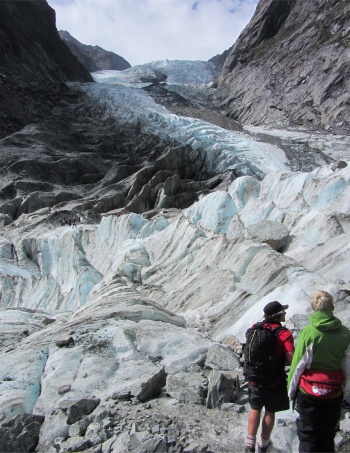 On the Lower Slopes of the Glacier, the "Waves" Directly Behind the Dark Triangle in the Upper Central Portion of the Glacier |
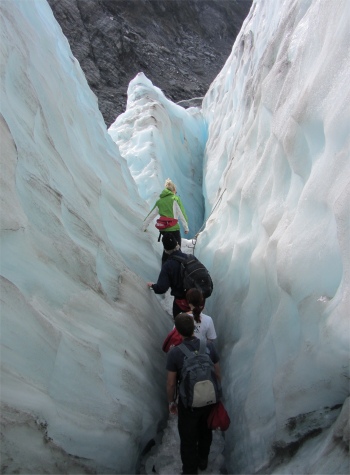 Climbing Up Through the Lower Icefield |
I assembled with about 50 other enthusiastic folks at the glacier guide centre, all raring to go on the 08:15 hike. We were all kitted out with raincoats, over-trousers, hats, gloves, boots, socks and a set of crampons. It was while I was milling about in the semi-chaos that I bumped into Carl, a chap a couple of years younger than myself. He hailed from Minnesota, and was enjoying a three month tramping holiday around the islands, covering many of the famous tramps. He was obviously a fit guy, and like almost all of us had never ventured on a glacier before, but he was relishing the challenge.
After a protracted start, we all managed to squeeze on a bus, with standing room only for some, and rocked and rolled along the Glacier Access Road for 10 minutes to a car park, where we all bailed out. Then it was off on a brisk walk along the Ka Roimata o Hine Hukatere Walk, passing Sentinel Rock along the way. Once we reached moraine debris, we paused and the guides got us to sort ourselves out into three different groups, basically: fast, medium and slow. "You'll all get to see and do the same things," advised a guide, but we found out later only the fast group accrued sufficient slack time to negotiate a few of the "interesting" features. Carl and I opted for the fast group. He also found to his dismay at this point that the battery in his camera was dead. Sod's Law.
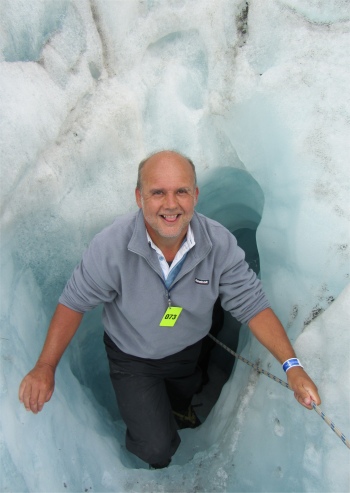 Lowering Myself Down into the Ice Tunnel |
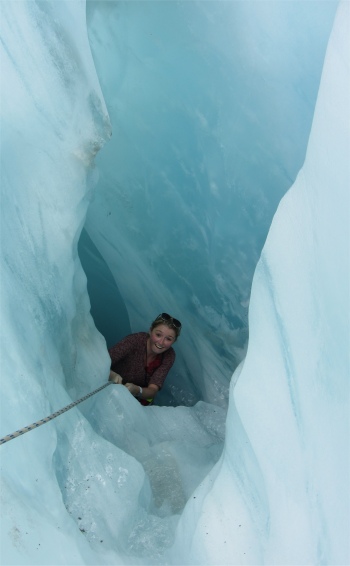 Scottish Girl Climbing Up Out of the Otherside of the Tunnel |
I could feel the chill from the icy surface from 50m away. Soon we were climbing up a lateral moraine. The point to note about this glacier is that it is mostly on an incline, with only a small area higher up which possessed a strip flat enough for helicopters to land. We made a steady climb until we reached a very small plateau. Here we were shown how to put our crampons on. We were also asked to sort ourselves out into two further groups: a fast group and a super-fast group. Carl and I opted for the latter, and our new guide was to be Mark, who preferred to be called Tubs.
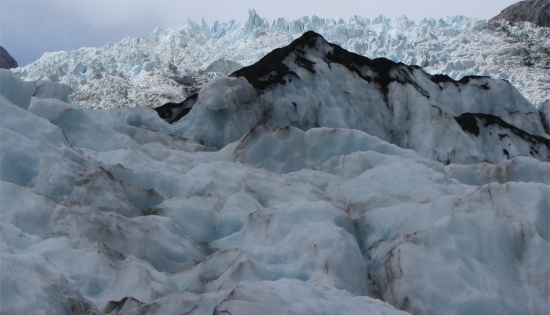 Dark Triangle with the Waves Behind and the Impossible Pinnacles in the Background 2km Away |
At first it was a little awkward walking on rock wearing crampons. However, the crampons came into their own when we reached ice; first a dirty ice covered with loose rock and gravel, and soon we moved out onto pristine ice.
It was necessary to apply a stamping action on the crampons to get a good grip, but we soon got the hang of it. We climbed up and down, we weaved our way between huge flakes of ice, often straddling the crevice below. What would have happened if somebody slipped into the crevice I'd hate to think; apart from the broken bones, how on earth could they be extracted from the bottomless tight squeeze? Best not think about it, I thought.
All the time we were gaining height, and our guide was often labouring away with his long pick axe cutting steps into the ice with huge cartwheel swings. That looked like quite a dangerous task to me. Occasionally we needed to use the assistance of ropes to ascend or descend huge blocks of ice.
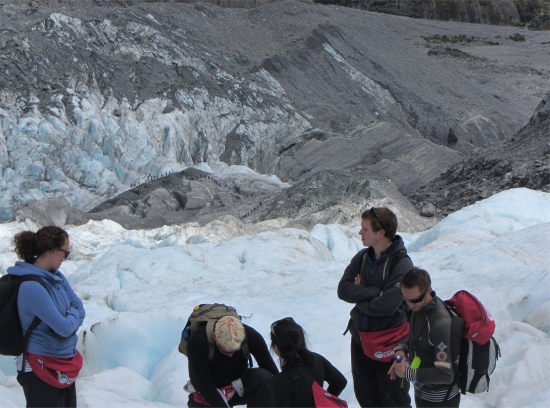 Other Groups Like Ants Far Below on Lower Icefield |
We were flying up the glacier. At one point Tubs noted that we were 25 minutes ahead of schedule. The idea behind the fast pace is that once high up on the glacier, we would have more time to explore and push the boundaries.
The surface of the glacier was now a mixture of opaque textured white ice, and translucent shiny blue ice. Tiny streams flowed in all direction as meltwater found its path of least resistance down to the river below, at times converging onto a blue hole which disappeared down into the deep. Cracks and holes of an intense blue were scattered across the ice surface, often filled with crystal clear freezing water. Occasionally rock debris would be straddled across the gap between large flakes of ice. This was a visually stunning landscape.
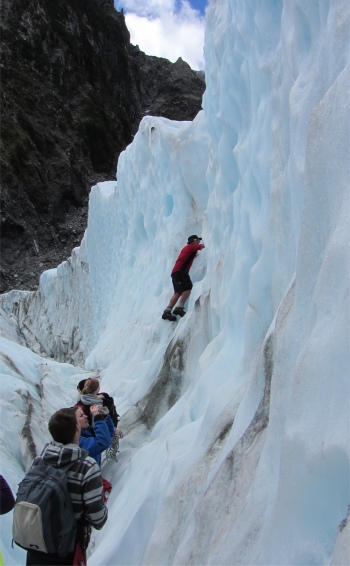 Tubs Finding a Route Across the Waves of Ice |
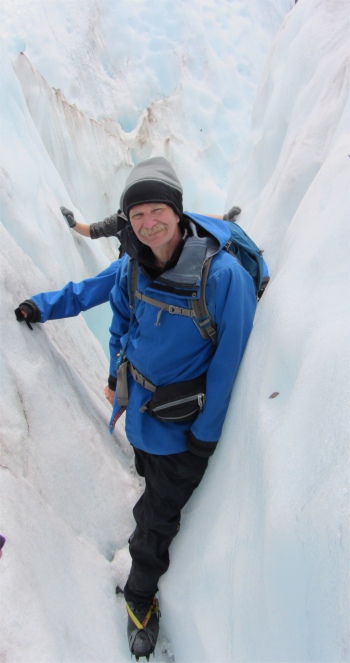 Carl Taking a Breather |
The glacier at this point was tumbling over a cliff in the valley floor. As it did so, the ice flowed over the edge and cracked transversally across the valley, effectively resembling broad "waves" of ice, the "waves" being up to 10m high. This section of the glacier was called the maze, quite appropriately since progress up through it would involve working our way through the troughs of the waves with no ability to see over each wave to determine the next stage of the route.
With lunch finished, our body temperatures plummeting due to lack of movement, and drops of rain starting to appear, we set off to try and find a route up the maze. Helicopters buzzed over our heads as they ferried folk back and forth to the small flat area just above the maze. We slithered our way along the long transverse troughs until Tubs found a possible route across a wave, and then he would cut steps into the ice and attach ropes so that we could clamber up and over the wave down into the next trough. I noticed in the waves perfect leaf shaped holes in the ice, with a leaf about a centimetre deep at the bottom of the hole. Obviously the dark leaf absorbed sunlight, raising the temperature around the leaf sufficiently to allow it to "burn" its way into the ice.
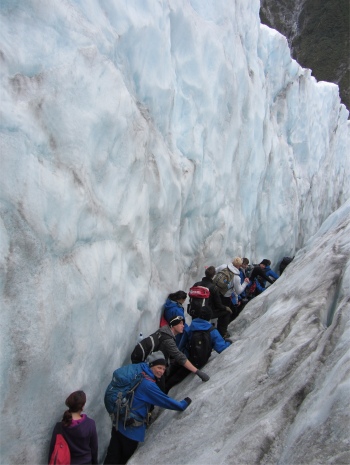 Time to Make a Retreat |
By now the fast group had caught up with us since they were just using the steps that Tubs had been cutting. The two guides then decided to try and find a different way back down through the maze, rather than retrace our steps; the challenge I guess. It wasn't easy, in fact it was painfully slow, and we were now behind schedule.
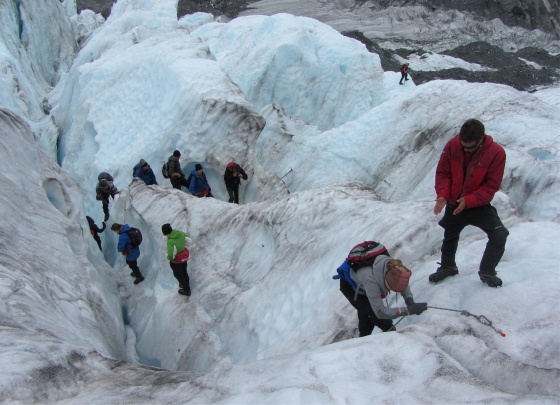 Picking Our Way Down Through the Waves, Tubs Ahead Reconnoitring |
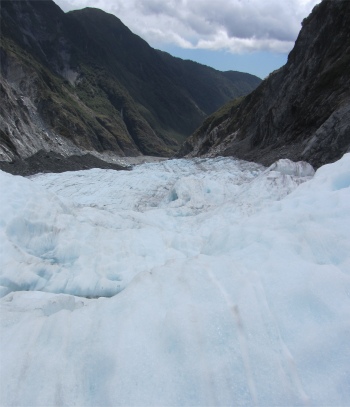 Still a Long Way Down |
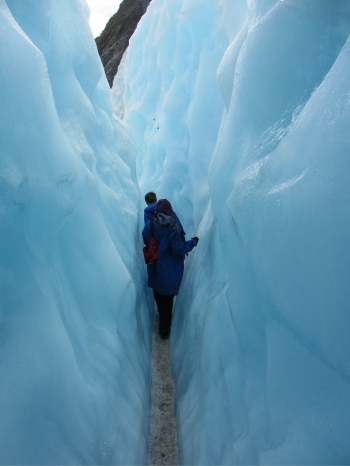 Blue Ice |
We carried on our rapid descent, and once we reached the lateral moraine, I asked Tubs how far up we had gone. He pointed up to a dark triangle on the ice that we could all recognise, and the waves of ice rearing up behind it. We had reached a point only three waves below the flat icefield where the helicopters landed. Effectively we had climbed up to 900m, the highest our guide had been in the six years he had been working for the company. So, Tubs had set a new personal best. We had walked around 10km over 8.5 hours, not bad for a day's hiking on a glacier.
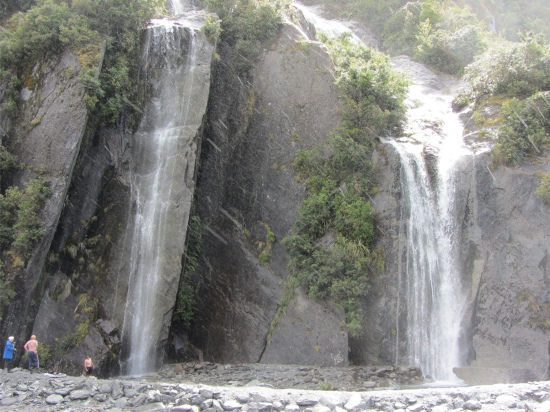 Shower in the Waterfalls |
Once back in town I headed off to the hot pools. Like the campsite which was nearby, these too seemed to be buried in the bush. Here I just soaked in pools of 36�C, 38�C and 40�C, just the ticket for tired muscles - sheer bliss. Carl turned up later, and before I went off to catch up on my notes we arranged to share a meal and a beer later,
When we met up for food, Amelia, who was also on the glacier hike today, joined us. We decided to dine at The Landing, the restaurant/bar where Tubs was having his farewell do. He was already quite tipsy when we bought him a beer; he had already gone through the tradition of drinking beer out of his boots.
We had a delightful meal where we learned a bit more about each other. Carl had been an electrician all his life, but had taken early retirement through a neck injury; a common complaint with electricians I gather. Amelia was a doctor in residence at a hospital in Irvine, California, on the road between Los Angeles and San Diego. The poor lass was almost always working in excess of 60 hours per week, and 100 hours per week stunts are quite common. I was gobsmacked when she revealed that her tuition fees, which she has to pay back, came to $250k - gulp! "Do you have to take out insurance in case somebody sues you?" I asked, knowing that the answer would be yes, but curious as to how bad it would be. "Sure, it costs me $300k per year," she answered. Carl gave a large, "Wow!" at that. I didn't have the nerve to ask how much she earned if she was paying that sort of annual premium.
We discussed travel, and our modes of travel. Amelia was negotiating the islands by bus, and was staying at hostels. Carl had rented a car and was staying at hostels. On hearing what he was paying for his rental, I considered that the deal I got was exceptionally good value for money.
All too soon it was way past 11pm, so we called it a day and went our separate ways, wishing each other safe journey. A lovely end to the day.
